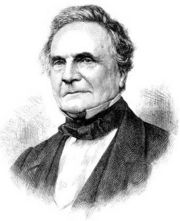查尔斯·巴贝奇
出自 MBA智库百科(https://wiki.mbalib.com/)
查尔斯·巴贝奇(Charles Babbage,1792—1871):科学管理的先驱者,第一台可编程的机械计算机的设计者
目录 |
巴贝奇出生于一个富有的银行家的家庭,曾就读于剑桥大学三一学院。
- 1812年他协助建立了分析学会,其宗旨是向英国介绍欧洲大陆在数学方面的成就。该学会推动了数学在英国的复兴。
- 1814年和1817年先后获得文学学士和硕士学位。
- 1815—1827年期间在伦敦从事科学活动,1827—1828年期间在欧洲大陆考察工厂。
- 1828—1839年期间在剑桥大学任卢卡斯数学教授(原为伊萨克·牛顿的教席)。
巴贝奇在1812/1813年初次想到用机械来计算数学表;后来,制造了一台小型计算机,能进行8位数的某些数学运算。1823年得到政府的支持,设计一台容量为20位数的计算机。它的制造要求有较高的机械工程技术。于是巴贝奇专心从事于这方面的研究。他于1834年发明了分析机(现代电子计算机的前身)的原理。在这项设计中,他曾设想根据储存数据的穿孔卡上的指令进行任何数学运算的可能性,并设想了现代计算机所具有的大多数其他特性,但因1842 年政府拒绝进一步支援,巴贝奇的计算器未能完成。斯德歌尔摩的舒茨公司按他的设计于1855年制造了一台计算器。使真正的计算机则至到电子时代才制成。
| 影响世界进程的100位管理大师 | ||||||||||||||||||||||||||||||||||||||||||||||||||||||||||||||||||||||||||||||||||||||||||||||||||||
|---|---|---|---|---|---|---|---|---|---|---|---|---|---|---|---|---|---|---|---|---|---|---|---|---|---|---|---|---|---|---|---|---|---|---|---|---|---|---|---|---|---|---|---|---|---|---|---|---|---|---|---|---|---|---|---|---|---|---|---|---|---|---|---|---|---|---|---|---|---|---|---|---|---|---|---|---|---|---|---|---|---|---|---|---|---|---|---|---|---|---|---|---|---|---|---|---|---|---|---|---|
| ||||||||||||||||||||||||||||||||||||||||||||||||||||||||||||||||||||||||||||||||||||||||||||||||||||
| [编辑] |
巴贝奇在24岁时就被选为英国皇家学会会员。他参与创建了英国天文学会和统计学会,并且是天文学会金质奖章获得者。他还是巴黎伦理科学院、爱尔兰皇家学会和美国科学学院的成员。
他的主要著作有:
- 《各种人寿保险机构的比较观点》(1826)
- 《关于科学在英国的衰落及其某些原因的思考》(1830)
- 《对数表样本》
- 《论机器和制造业的经济》(1832)
- 《有关征税原则的思考、关于财产税及其免除》(1848)
- 《一个哲学家生涯的片段》(1864)
此外,还有以下一些论文:
- 《机器在数学表计算中的应用》(1822)
- 《论用符号表示机器动作的方法》(1826)
- 《关于调节机器的应用一般原则的论文》(1829)
发明分析机
1823年得到政府的支持,设计一台容量为20位数的计算机。它的制造要求有较高的机械工程技术。
于是巴贝奇专心从事于这方面的研究。他于1834年发明了分析机(现代电子计算机的前身)的原理。在这项设计中,他曾设想根据储存数据的穿孔卡上的指令进行任何数学运算的可能性,并设想了现代计算机所具有的大多数其他特性,但因 1842 年政府拒绝进一步支援,巴贝奇的计算器未能完成。斯德歌尔摩的舒茨公司按他的设计于1855年制造了一台计算器。使真正的计算机时至到电子时代才制成。 巴贝奇在24岁时就被选为英国皇家学会会员。他参与创建了英国天文学会和统计学会,并且是天文学会金质奖章获得者。他还是巴黎伦理科学院、爱尔兰皇家学会和美国科学学院的成员。
Babbage sought a method by which mathematical tables could be calculated mechanically, removing the high rate of human error. Three different factors seem to have influenced him: a dislike of untidiness; his experience working on logarithmic tables; and existing work on calculating machines carried out by Wilhelm Schickard, Blaise Pascal, and Gottfried Leibniz. He first discussed the principles of a calculating engine in a letter to Sir Humphry Davy in 1822.
Babbage's machines were among the first mechanical computers, although they were not actually completed, largely because of funding problems and personality issues. He directed the building of some steam-powered machines that achieved some success, suggesting that calculations could be mechanized. Although Babbage's machines were mechanical and unwieldy, their basic architecture was very similar to a modern computer. The data and program memory were separated, operation was instruction based, the control unit could make conditional jumps and the machine had a separate I/O unit.
- 差分机(Difference engine)
In Babbage’s time, numerical tables were calculated by humans who were called ‘computers’, meaning "one who computes", much as a conductor is "one who conducts". At Cambridge, he saw the high error-rate of this human-driven process and started his life’s work of trying to calculate the tables mechanically. He began in 1822 with what he called the difference engine, made to compute values of polynomial functions. Unlike similar efforts of the time, Babbage's difference engine was created to calculate a series of values automatically. By using the method of finite differences, it was possible to avoid the need for multiplication and division.
The first difference engine was composed of around 25,000 parts, weighed fifteen tons (13,600 kg), and stood 8 ft (2.4 m) high. Although he received ample funding for the project, it was never completed. He later designed an improved version, "Difference Engine No. 2", which was not constructed until 1989-1991, using Babbage's plans and 19th century manufacturing tolerances. It performed its first calculation at the London Science Museum returning results to 31 digits, far more than the average modern pocket calculator.
- 完成模型(Completed models)
The London Science Museum has constructed two Difference Engines, according to Babbage's plans for the Difference Engine No 2. One is owned by the museum; the other, owned by technology millionaire Nathan Myhrvold, went on exhibit at the Computer History Museum in Mountain View, California on 10 May 2008.The two models that have been constructed are not replicas; until the assembly of the first Difference Engine No 2 by the London Science Museum, no model of the Difference Engine No 2 existed.
- 分析引擎(Analytical engine)
Soon after the attempt at making the difference engine crumbled, Babbage started designing a different, more complex machine called the Analytical Engine. The engine is not a single physical machine but a succession of designs that he tinkered with until his death in 1871. The main difference between the two engines is that the Analytical Engine could be programmed using punch cards. He realized that programs could be put on these cards so the person had only to create the program initially, and then put the cards in the machine and let it run. The analytical engine would have used loops of Jacquard's punched cards to control a mechanical calculator, which could formulate results based on the results of preceding computations. This machine was also intended to employ several features subsequently used in modern computers, including sequential control, branching, and looping, and would have been the first mechanical device to be Turing-complete.
Ada Lovelace, an impressive mathematician, and one of the few people who fully understood Babbage's ideas, created a program for the Analytical Engine. Had the Analytical Engine ever actually been built, her program would have been able to calculate a sequence of Bernoulli numbers. Based on this work, Lovelace is now widely credited with being the first computer programmer.In 1979, a contemporary programming language was named Ada in her honour. Shortly afterward, in 1981, a satirical article by Tony Karp in the magazine Datamation described the Babbage programming language as the "language of the future".
- 现代改编(Modern adaptations)
While the abacus and mechanical calculator have been replaced by electronic calculators using microchips, the recent advances in MEMS and nanotechnology have led to recent high-tech experiments in mechanical computation. The benefits suggested include operation in high radiation or high temperature environments.
These modern versions of mechanical computation were highlighted in the magazine The Economist in its special "end of the millennium" black cover issue in an article entitled "Babbage's Last Laugh".The article highlighted work done at University of California Berkeley by Ezekiel Kruglick. In this Doctoral Dissertation the researcher reports mechanical logic cells and architectures sufficient to implement the Babbage Analytical engine (see above) or any general logic circuit. Carry-shift digital adders and various logic elements are detailed as well as modern analysis on required performance for microscopic mechanical logic.
巴贝奇从小就养成对任何事情都要寻根究底的习惯,拿到玩具也会拆开来看看里面的构造。以后他又受了数学和其他科学的训练并考察了许多工厂。这使得他在管理方面提出了许多创见和新的措施。他的贡献主要有以下几点:
- 提出了在科学分析的基础上的可能测定出企业管理的一般原则。他在《论机械和制造业的经济》一书中指出:“我在过去10年中曾被吸引去访问英国和欧洲大陆的许多工场和工厂,以便熟悉其机械工艺,在这过程中,我不由自主地把我在其他研究中自然形成的各种一般化原则应用到这些工场和工厂中去。” 这同80年代以后泰罗在《科学管理原理》一书中的下述一段话是很相似的(虽然泰罗并不知道巴贝奇的著作)。泰罗说:“有些人的教育使他们养成了概括并在各处寻找规模的习惯。当这些人碰到了在每一行业中都存在并极为相似的许多问题以后,他们不可避免地试图把这些问题进行逻辑归类,并找出解决这些问题的某些规律或规则。”
- 他设计出世界上第一台计算机。他于1823年设计出来的小型差数——世界上第1台计算机虽然没有制成,但其基本原理于92年后被应用于巴勒式会计计算机。他还利用计数机来计算工人的工作数量、原材料的利用程度等。他把这叫做“管理的机械原则”。
- 他制定了一种“观察制造业的方法”。这种方法同后来别人提出的“作业研究的科学的、系统的方法”非常相似。观察者用这种方法进行观察时利用一种印好的标准提问表。表中包括的项目有:生产所用的材料,正常的耗费、费用、工具、价格,最终市场,工人、工资、需要的技术,工作周期的长度等。
- 他进一步发展了亚当·斯密关于劳动分工的利益的思想,分析了分工能提高劳动生产率的原因。他指出,这些原因是:
- 节省了学习所需要的时间。生产中包含的工序愈多,则所需要的学习时间愈长。例如一个工人无需从事全部工序而只做其中少数工序或一道工序,就只需要少量的学习时间。
- 节省了学习中所耗费的材料。因为在学习中都要耗费一定的材料。实行劳动分工后,需要学习的内容减少了,所耗费的材料也相应地减少。
- 节省了从一道工序转变到另一道工序的耗费的时间。而且,由于分工后经常作某一项作业,肌肉得到了锻炼,就更不易疲劳。
- 节省了改变工具所耗费的时间。在许多手艺中,工具常常是很精细的,需要作精密的调节。调节这些工具所占的时间相当多,分工后就可以大大节省这些时间。
- 由于经常重复同一操作,技术熟练,工作速度可以加快。
- 分工后注意力集中于比较单纯的作业,能改进工具和机器,设计出更精致合用的工具和机器,从而提高劳动生产率。
巴贝奇还指出,脑力劳动也同体力劳动一样地可以进行分工。他指出,法国桥梁和道路学校校长普隆尼把他的工作人员分成技术性、半技术性、非技术性3类,把复杂的工作交给有高度能力的数学家去做,把简单的工作交给只能从事加减运算的人去做,从而大大提高了整个工作的效率。
- 他进行了有关工作时间问题的研究。在这项研究中,他征得同意后引用了法国库伦布的观察材料。这是在管理问题上国际合作的最早范例。
- 在劳资关系方面,他强调劳资协作,强调工人要认识到工厂制度对他们有利的方面。这也同泰罗在几十年后发表的论点很相似。他提出一种固定工资加利润分享的制度,认为这种制度有以下的好处:
- 每个工人同工厂的发展和利润的多少有直接的利害关系;
- 每个工人都会关心浪费和管理不善的问题;
- 能促使每个部门改进工作;
- 鼓励工人提高技术和品德,表现不好者减少分享的利润;
- 由于工人同雇主的利益一致,能消除隔阂,共求繁荣。
- 他还探讨了能使投资效率更高的大工厂的优越性,以及这些工厂对原料来源的恰当位置;工艺过程和制造成本的分析(如在制针业中);在同一领域中各个企业的比较研究。(如《各种人寿保险机构的比较观点》)等。









我们要学习他